Step-by-Step Guide to Building Your Own AI Chatbot
Nauman Pathan
February 15, 2025 103 Views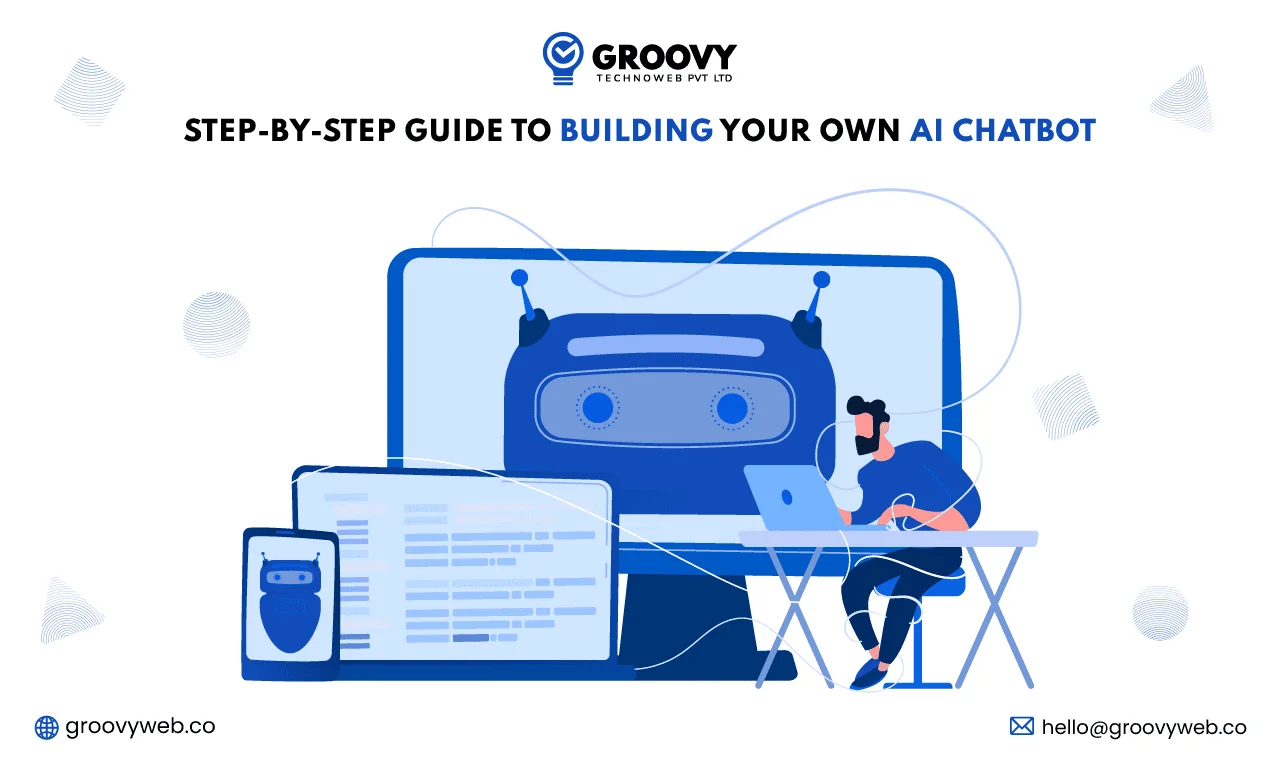
Quick Summary : This comprehensive guide explores the growing significance of AI chatbots in revolutionizing customer engagement and streamlining business operations. Learn how to build an AI chatbot step-by-step, from defining goals and selecting the right platform to training, testing, and deploying it effectively. The blog also addresses common challenges in chatbot development, highlights the importance of professional services, and demonstrates how chatbots enhance customer experiences across industries like e-commerce, healthcare, and finance.
Artificial intelligence is one of the pillars of technological growth, and AI chatbots represent one of the most visible applications of this technology. Digital assistants are changing how businesses interact with their customers: by automating routine tasks, providing personalized experiences, and being available 24/7. AI chatbots have streamlined every industry, from retail to healthcare operations.
As Mordor Intelligence predicted, the global chatbot market chatbots would be at approximately 3.78 billion in 2021 but increase to approximately 10.08 billion in 2026. The fundamental aspect of this shift is that progressively, more customers need tools showing conversational AI to raise the customer experience as well as operational costs. It has become a step toward companies’ survival in the new digital world because developing an AI chatbot makes them competitive with their competitors in the business.

In this article, we’re going to explain how to make an AI chatbot, its significance in modern industries, and give a step-by-step roadmap for building your chatbot solution. If you need expert help, check out our AI ChatBot development services to see how we can help you build a cutting-edge solution designed around your business needs.
Why Choose Professional Chatbot App Development Services
While it is possible to build a chatbot in-house, the complexity of development, deployment, and maintenance often necessitates professional expertise. Here’s why hiring experts can be beneficial:
1. Advanced Feature Implementation
Professional developers provide experience in developing complex features, for example, predictive analytics, sentiment analysis, and voice recognition. Such features give the chatbot more functionality and usability.
Such companies as Groovy Web show great potential for innovative feature implementation, according to modern business demands.
2. Custom Solutions
Every business has unique needs, and off-the-shelf chatbots often fall short. Experts can craft solutions tailored to specific requirements, ensuring better alignment with business goals. Groovy Web’s approach emphasizes understanding individual client needs to deliver personalized chatbot solutions.
3. Long-Term Support and Maintenance
Chatbots need to be constantly updated for them to work. Development teams can offer frequent support so that your chatbot grows with changing customer needs and advancements in technology. We offer extensive post-deployment services so that your chatbot stays at the cutting edge.
4. Seamless Integration
Integrating a chatbot with existing systems requires deep knowledge of APIs and software architecture. Professionals ensure smooth deployment across platforms, minimizing downtime and maximizing efficiency. Groovy Web’s expertise in system integration ensures that your chatbot fits seamlessly into your existing operations.
Why AI Chatbots Are Essential in Today’s World
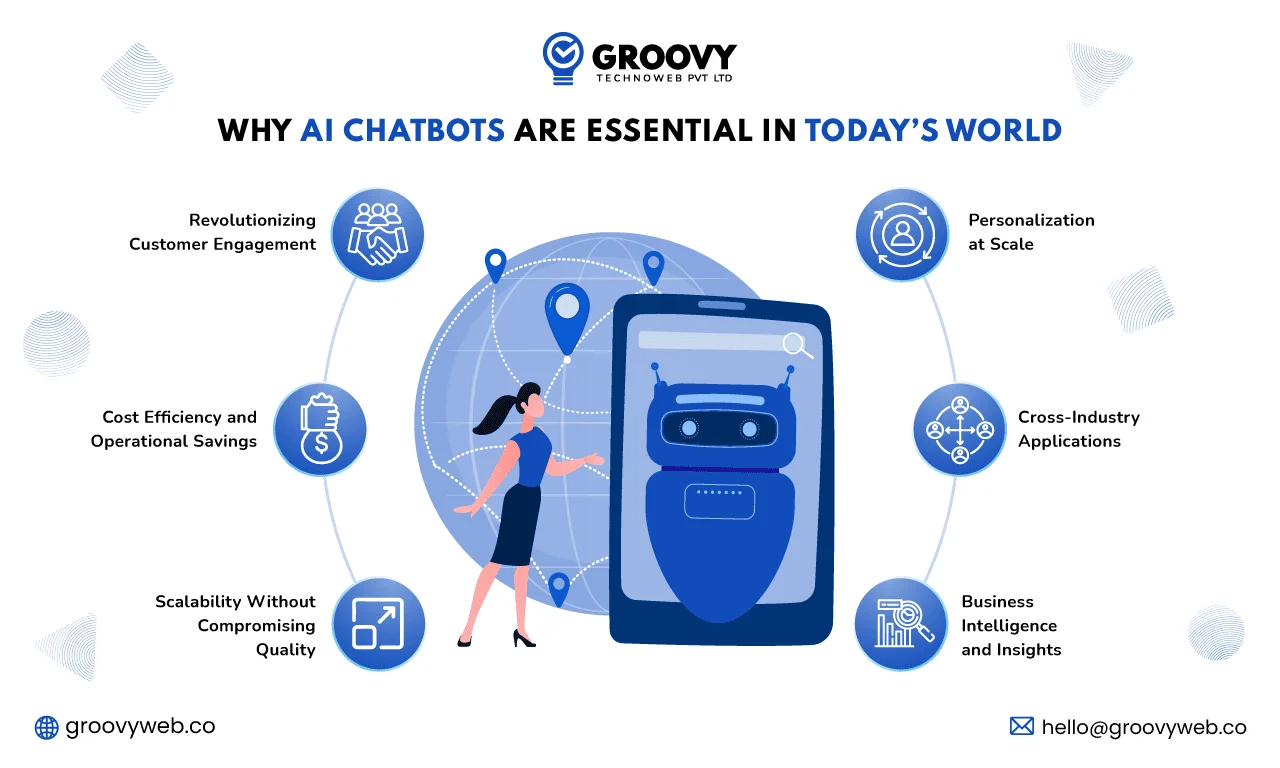
1. Revolutionizing Customer Engagement
AI chatbots are changing the way businesses interact with their customers. With instant, accurate, and context-aware responses, businesses can address customer queries effectively. Unlike any other traditional channels of customer service, the round-the-clock working feature of chatbots ensures uninterrupted service. This also improves customer satisfaction and loyalty through real-time addressing of queries.
2. Cost Efficiency and Operational Savings
Chatbots can drastically reduce the operational cost of a business. According to Juniper Research, by 2025, chatbots are expected to save businesses more than $11 billion annually through the reduction of large customer support teams.
For example, AI-based bots can help in answering repeated queries freeing human agents for more complex work.
3. Scalability Without Compromising Quality
AI chatbots scale to thousands of interactions at the same time, with maintaining quality in their response. This makes them very valuable for companies that experience a high traffic volume; for instance, when they have promotional offers or seasonal sales.
Furthermore, advanced natural language processing through the application of AI in chatbots guarantees flawless and proper communication among vast audiences.
4. Personalization at Scale
By analyzing the behaviour, preferences, and previous interactions of the users, the chatbots can personalize their response to the users’ needs. For instance, in e-commerce, chatbots can suggest items based on the browsing history, which enhances the experience of the user.
5. Cross-Industry Applications
AI chatbots are diversified tools for multiple industries. Some of the domains for which these chatbots can be used are as follows:
- E-commerce: Providing the customer with product recommendations, order tracking, and FAQs.
- Healthcare: Schedule appointments with doctors, remind patients to take medicine and answer any health-related queries.
- Finance: Currently open accounts, automate payments, and provide investment information.
- Education: Virtual guidance, recommend classes.
6. Business Intelligence and Insights
Chatbots collect massive data from their users. This data helps businesses produce actionable insights into customer preferences and behaviour. These insights better enable businesses in strategy refinement, optimized marketing, and improvement of product and service offers.
Understanding the Basics of AI Chatbots
What is an AI Chatbot?
An AI chatbot is a software application designed to simulate human-like conversations using NLP and ML. It differs from the traditional rule-based bots that use pre-written scripts; the AI chatbots learn and evolve with time, so their responses become more accurate and context-aware. They are capable of understanding the intent of the user, analyzing input, and giving meaningful responses in real time.
Rule-Based vs. AI-Driven Chatbots
| Feature | Rule-Based Chatbots | AI-Driven Chatbots |
| Logic | Predefined scripts and rules | Machine learning algorithms and NLP |
| Flexibility | Limited; works well for simple queries | Highly flexible; adapts to complex queries |
| Learning | Static, no learning capabilities | Continuously learns from interactions |
| Examples | Menu-based systems, IVR systems | Siri, Alexa, Google Assistant |
Popular Examples of AI Chatbots
- Siri (Apple): A virtual assistant that completes tasks and responds to questions based on AI and voice recognition.
- ChatGPT (OpenAI): Known for its ability to generate human-like text responses for a variety of use cases.
- IBM Watson Assistant: Assists businesses in deploying conversational solutions that meet their needs.
- Dialogflow (Google): A platform to build conversational interfaces that will integrate well into multiple channels.
Planning Your AI Chatbot: Setting the Foundation
1. Define Your Goals
Define clear and measurable objectives to begin creating an AI chatbot. Consider the following:
- Purpose: What problem will the chatbot solve? For example, customer support, lead generation, and appointment booking.
- Target Audience: Who will interact with the chatbot? Knowing your audience helps in designing relevant responses.
- Platform: Decide where the chatbot will operate, such as on a website, mobile app, or messaging platforms.
2. Understand Your Audience
Knowing your audience is critical to crafting meaningful interactions. Conduct research to:
- Identify common user queries.
- Understand user behavior and preferences.
- Pinpoint pain points that the chatbot can address.
3. Select Key Features
Your chatbot’s features should align with its goals and audience needs. Some essential features include:
- Natural Language Processing (NLP): For understanding and interpreting user input.
- Integration with Third-Party Tools: Such as CRM systems and payment gateways.
- Multi-Language Support: To cater to a diverse audience.
- Analytics and Insights: To monitor performance and gather user data for improvement.
Step-by-Step Guide to Building Your AI Chatbot
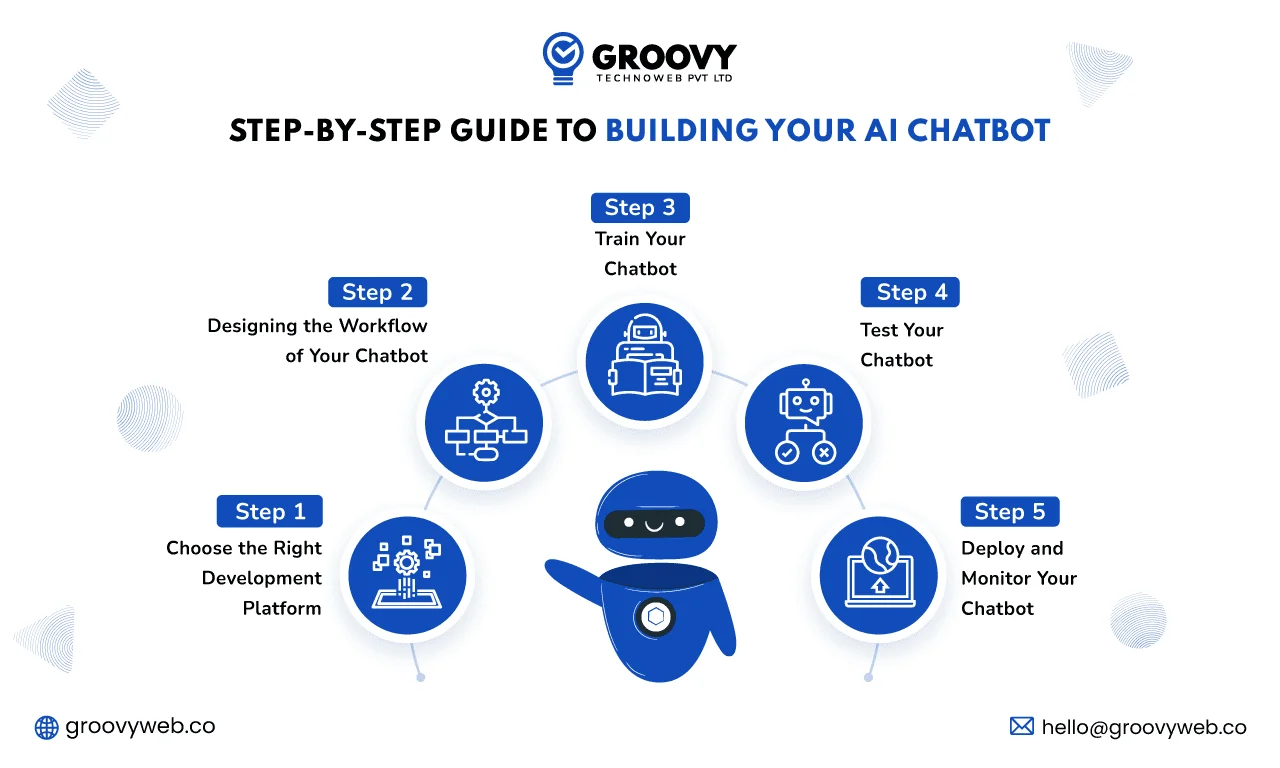
Step 1: Choose the Right Development Platform
The foundation of any AI chatbot is the selection of the right development platform. Your choice will depend on factors such as budget, technical expertise, and the complexity of your chatbot requirements. Here are three popular platforms:
- Dialogflow (Google): It is easy to use and comes with great NLP capabilities. It supports integration with WhatsApp, Slack, and websites seamlessly. Companies are using it for its ease of use and support for multiple languages.
- Rasa: It is an open-source framework for custom chatbot development. Rasa is suitable for those developers who want more control and flexibility over their chatbot’s functionality.
- Microsoft Bot Framework: This is the hallmark of enterprise-grade solutions. This platform provides a holistic set of tools to build and deploy bots across multiple channels.
Selection of a platform depends on factors like:
- Scalability: whether the platform can handle increasing traffic?
- Integration: does it integrate with third-party tools such as CRMs?
- Customization: to what extent does it offer control over the behaviour of the chatbot?
Step 2: Designing the Workflow of Your Chatbot
A good workflow will keep your chatbot providing a smooth experience for the user. Important steps involve:
- Charting Conversation Flows: Use platforms like Lucidchart or Draw.io to sketch out the different interactions your chatbot should have. Define entry points, decision nodes, and exit points.
- Defining Intents: Intents are the user’s goals (e.g., booking a flight, or checking an account balance). Each intent should have a clear purpose and associated response
- Setting Up Responses: Write conversational, user-friendly messages. Use a mix of text, buttons, and rich media to make interactions engaging.
Step 3: Train Your Chatbot
Training your chatbot is a critical step in ensuring it provides accurate and contextually relevant responses.
- Collect Training Data: Collect data from several sources, including customer support transcripts, FAQs, and previous chatbot interactions. Ensure the data covers a wide range of possible user inputs.
- Clean the Data: Remove duplicates or irrelevant entries, correct typos, and format the data for consistency. Clean data improves the efficiency and accuracy of the chatbot.
- Create Intents and Entities: Group the data into intents (user goals) and entities (specific information such as dates, names, or locations).
- Use Pre-trained Models: Platforms like Dialogflow and Rasa provide pre-trained NLP models that can expedite the training process and improve accuracy.
- Test and Refine: Continuously evaluate the chatbot’s performance during training. Use real-world queries to identify gaps and fine-tune the responses.
Step 4: Test Your Chatbot
Testing will ensure your chatbot is ready for the real world. Some of the major steps include:
- Functional Testing: It tests that all functions in the chatbot are working properly, including input recognition and responses.
- Usability Testing: This step ensures the user-friendliness of the chatbot.
- Stress Testing: It determines how well the chatbot works under heavy traffic and weird queries.
- Common Testing Tools: Botium and TestMyBot are some of the most popular testing tools used.
Step 5: Deploy and Monitor Your Chatbot
Deploying your chatbot means integrating it with your chosen platform(s) and monitoring its performance. Key considerations are:
- Integration: Integrate a chatbot into your website, mobile app, or popular chatting apps like WhatsApp and Facebook to enhance customer engagement.
- Performance Monitoring: Use analytics tools to track user interactions, response times, and user satisfaction.
- Continuous updates: Improves the accuracy of the chatbot and introduces new functions to the system.
Tools and Technologies for AI Chatbot Development
For developing an AI chatbot, the right tools and frameworks need to be engaged and leveraged towards meeting your project’s specific needs.
1. Popular Tools for Chatbot Development
- Dialogflow: It is developed by Google. This NLP-based platform gives clients strong features like voice integration, multilingual support, and easy integration with different platforms.
- Rasa: The open-source framework allows developers the freedom to control `what they can or cannot customize and its deployment.
- Microsoft Bot Framework: Famous for its extensive toolkit, it supports multi-channel and is very compatible with Azure.
- IBM Watson Assistant: Ideal for enterprise-grade solutions, with pre-trained AI models and advanced analytics capabilities.
2. Technologies Behind Chatbot Development
- Natural Language Processing (NLP): This allows the chatbot to understand and process user input. Examples include spaCy, NLTK, and Google’s BERT.
- Machine Learning Models: This algorithm, such as Random Forest, SVM, and Deep Learning, enhances the accuracy and adaptability of a chatbot.
- Integration APIs: Tools like Twilio and Zapier help build the connection between CRMs, payment gateways, and third-party applications with chatbots.
| Tools/Framework | Best for | Customization | Ease of Use | Cost |
| Dialogflow | Quick Implementation | Moderate | Easy | Pay-as-you-go |
| Rasa | Full control over development | High | Moderate | Free/Open-Source |
| Microsoft Bot Framework | Enterprise-level Integration | High | Moderate | Azure-based |
| IBM Watson Assistant | Data-heavy Applications | Moderate | Moderate | Subscription |
You would understand the strengths and weaknesses of each tool in order to determine the most appropriate platform to use for chatbot development.
Best Practices for Developing an Effective AI Chatbot
Creating a successful chatbot involves more than just technology. Here are key best practices:
1. Prioritize User Experience
- Design conversations that mimic human interactions.
- Include fallback responses to handle unexpected queries gracefully.
- Use a mix of text, buttons, and visuals for engagement.
2. Maintain Security and Privacy
- Encrypt sensitive data to protect user privacy.
- Follow industry standards like GDPR for data handling.
- Regularly audit and update security protocols.
3. Gather Feedback and Iterate
- Use analytics tools to monitor chatbot performance.
- Conduct user surveys to identify areas for improvement.
- Continuously update intents and responses based on user interactions.
4. Ensure Multichannel Availability
- Deploy the chatbot on multiple platforms (web, mobile, and messaging apps).
- Use APIs to ensure seamless cross-platform functionality.
5. Common Challenges in AI Chatbot Development
1. Handling Complex Queries
- Solution: Use advanced NLP models like BERT and GPT for better context understanding.
2. Data Scarcity
- Solution: Leverage pre-trained datasets and transfer learning techniques.
3. Privacy Concerns
- Solution: Employ encryption protocols and anonymize sensitive data.
4. Integration Issues
- Solution: Use robust APIs to ensure seamless compatibility with existing systems.
Closing Thoughts
Strategic planning, robust development, and continuous improvement characterize the process of creating an AI chatbot. With 24/7 support, operational efficiency, and actionable insights, AI chatbots revolutionize businesses. Although challenges do exist, professional services like Groovy Web make it easier to journey through this by integrating advanced features and aligning the chatbots with business goals.
Partner with the more experienced teams of Groovy Web to ensure high-tech, lag-free functionality and transformative results. Take the first step towards a conversational AI and elevate your business today!
Written by: Nauman Pathan
Nauman Pathan is a Project Manager at Groovy Web - a top mobile & web app development company. He is actively growing, learning new things, and adapting to new roles and responsibilities at every step. Aside from being a web app developer, he is highly admired for his project management skills by his clients.
Frequently Asked Questions
We hope these clear your doubts, but if you still have any questions, then feel free to write us on hello@groovyweb.coHow long does it take to build an AI chatbot?
The development timeline depends on the complexity of the chatbot and its features. A basic chatbot can take 2-4 weeks, while an advanced AI chatbot with integrations and custom functionalities may take 2-3 months or more.
What are the key benefits of using AI chatbots for businesses?
AI chatbots offer 24/7 customer support, reduce operational costs, improve response times, enhance user engagement, and provide actionable insights through data analysis.
Can AI chatbots handle multiple languages?
Yes, many AI chatbot platforms, such as Dialogflow and Rasa, support multilingual capabilities, allowing businesses to engage with diverse audiences effectively.
What industries benefit the most from AI chatbots?
AI chatbots are widely used in industries like e-commerce, healthcare, finance, education, and travel for tasks like customer support, lead generation, and personalized recommendations.
Related Blog
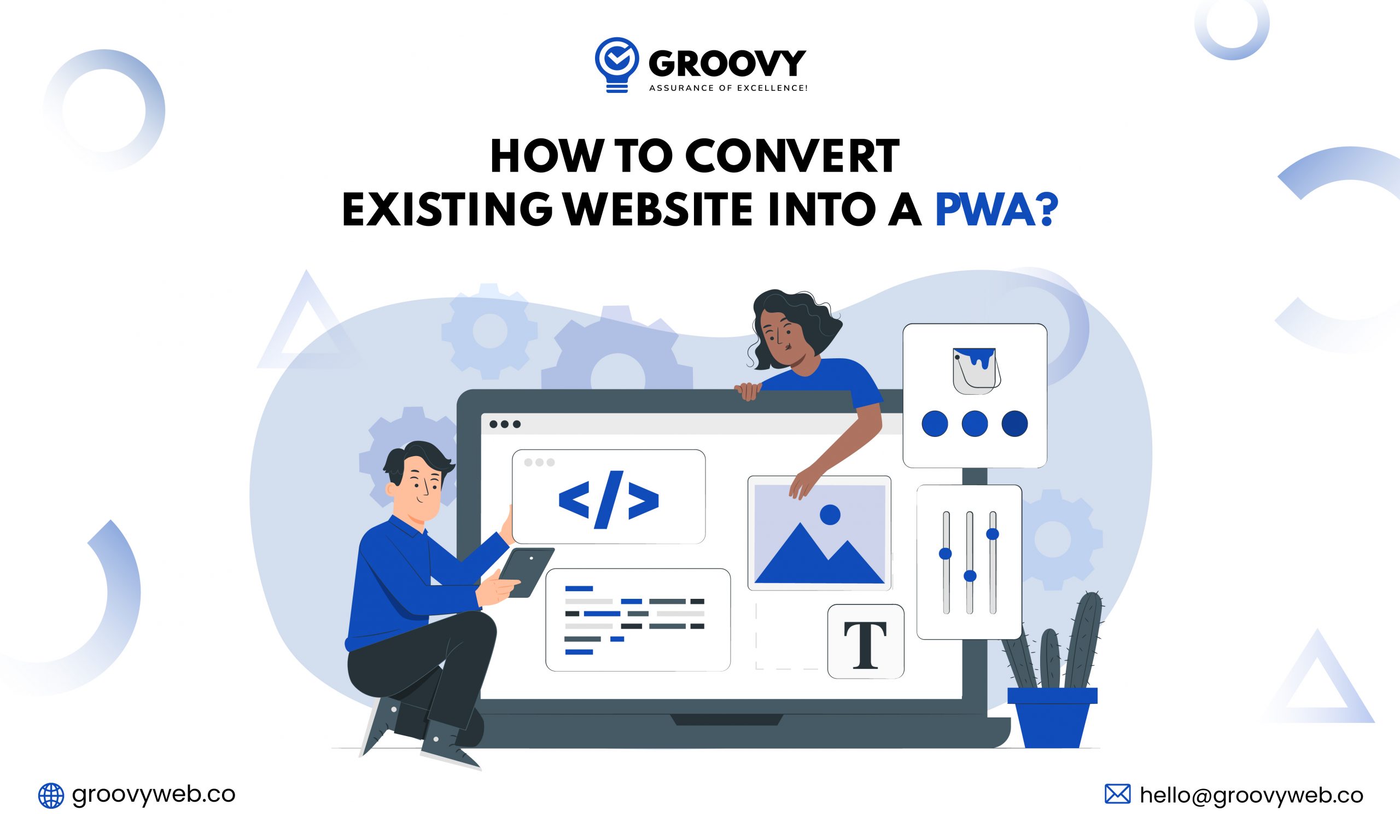
Nauman Pathan
How to Convert Existing Website into a PWA?
Web App Development 09 Jan 2025 10 min read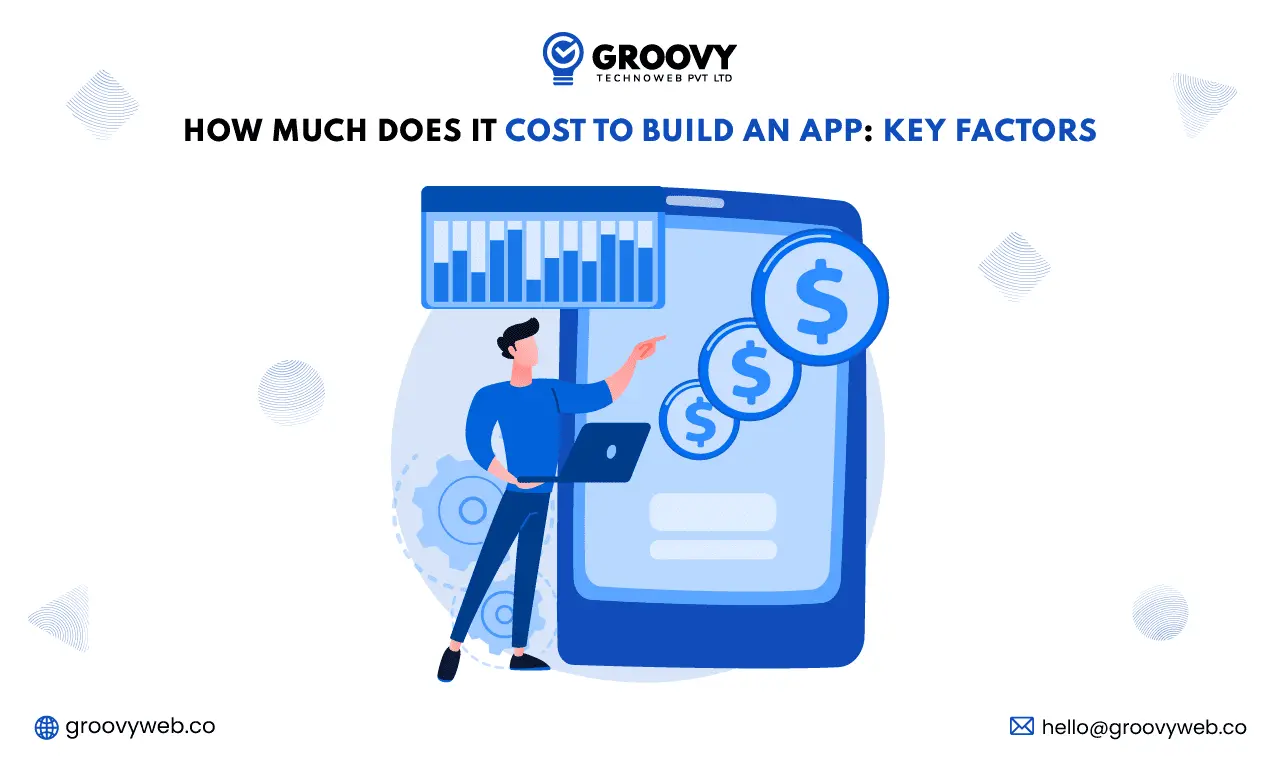
Rahul Motwani
How Much Does It Cost to Build an App: Key Factors
Mobile App Development 09 Jan 2025 12 min read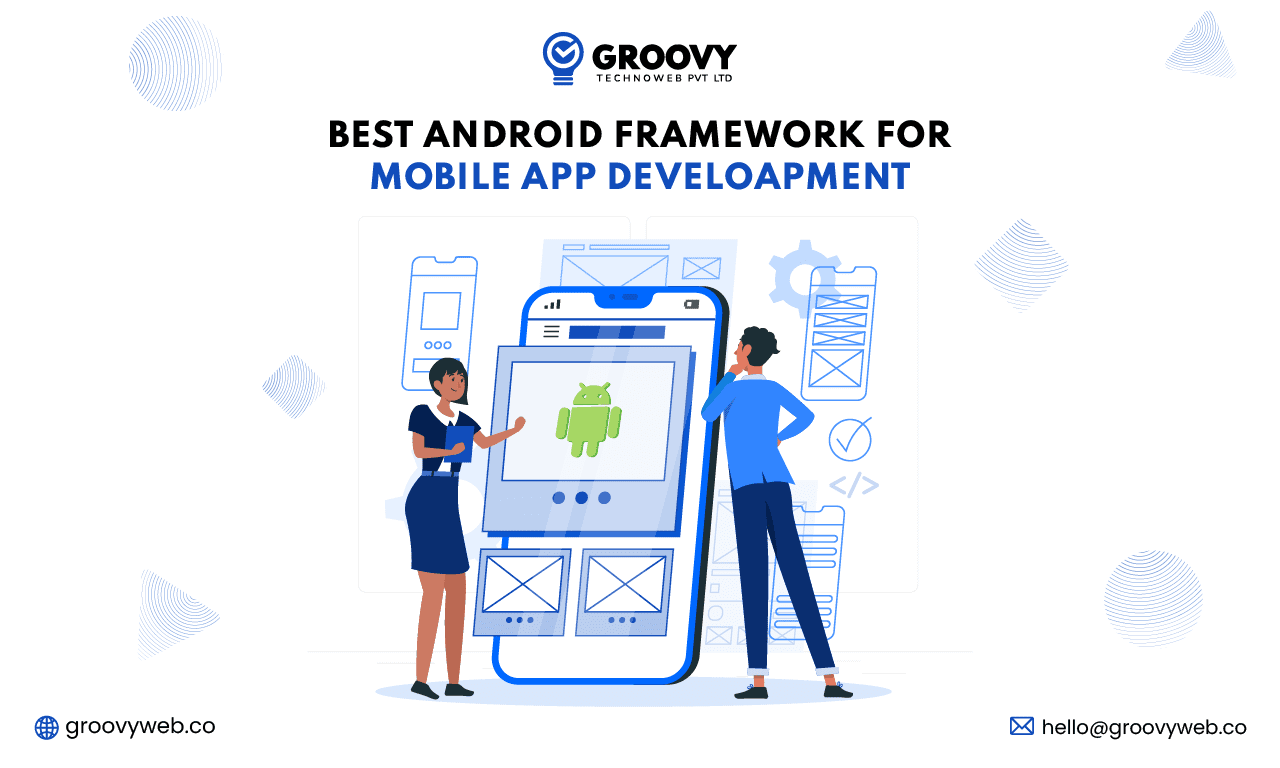
Rahul Motwani
Best Android Framework For Mobile App Development In 2023
Mobile App Development 08 Jun 2023 7 min readSign up for the free Newsletter
For exclusive strategies not found on the blog